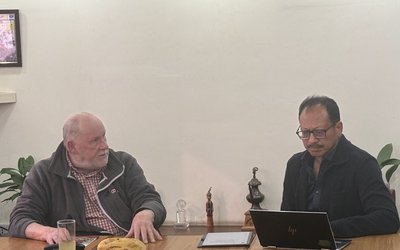Various media reports related to prediction of a possible earthquake in Nepal have created havoc in the public from time to time. How do you look at such predictions?
As Nepal is situated in an active seismic zone of the world, earthquakes are normal and natural in this region. However, no one can predict when the next earthquake will hit and in which part of Nepal. As a student of geology, what I can say is that Nepal’s mountains were formed by earthquakes, and earthquakes are part of our life. One has to understand this fact and needs to be prepared to face any major earthquake anytime any moment. There is no need to panic much. I understand the panic of the people as they had faced major earthquakes recently and the shaking of those earthquakes is still in their mind.
Why is there so much panic then?
If you are prepared well, and living in the earthquake resilient homes, there will be less damage. Earthquake is not a problem in Nepal, but the problem is the mentality of political leaders and officials who rarely consult with experts before taking major decisions.
Are the current reports unusual?
One has to know that Nepal lies in an active seismic zone. Nepal is always vulnerable to earthquakes. This fact is proven by various scientific studies and studies have been going on from time to time and scientists have been releasing their research reports on the basis of their model of studies about the earthquakes. I won’t be surprise to read about the possible predictions of earthquakes in Nepal. I would be surprised if somebody predicts the date and timing of a major earthquake. It will be surprising if some scientists say that Nepal will not have any earthquake.
On what grounds are you saying so?
Nepal has recorded several earthquakes of several scales in the past. Earthquake has created places like Tansen. We have several evidences of occurrences of earthquakes. Our studies have shown that many catastrophic landslides have connections with earthquakes. We have seen the landslides changing the course of rivers and landmasses. Our studies have shown that many major landslides like in Tal Gaun of Manang are not a result of monsoon rain and flood but results of shaking of the earth.
On what basis have the scientists been saying this?
We have many studies, sites and indications of past earthquakes. Earthquakes are not new to Nepal but we are taking it as a new because we have recently gone through a big earthquake. Recently, we have found several scientific evidences of how and when the earthquakes occurred in Nepal. If some say they found new indications of earthquake, we have to understand that there is another strong evidence of earthquake.
On what basis can one predict the earthquakes?
There are different methods to study earthquakes. Some studies are based on cluster methodology, some scientists are searching the ruptures in the Chure mountain range and its surroundings. For the scientists like me, I study the landslides to find out the evidences of earthquake. I have been studying how the earthquake create the landslides and block the rivers and made many places for human settlement and how many of our human settlements are above the landslide zones. This is our approach. Earthquake is not new in Himalayas and the earthquake occurs regularly in the region. What I can say now is that the frequencies of earthquake are few in comparison to the human life.
Just after the Gorkha Earthquake, you were demanding implementation of strong building codes and studies of soil, how has the government responded to scientists like you in the current process of reconstruction?
Frankly speaking, the government has done nothing to listen to the voices of scientists like me. Even the National Reconstruction Authority (NRA), the sole agency implementing reconstruction of earthquake resilient buildings and safe settlements, is ignoring us. Soon after the earthquake, we should have evaluated the land on possible landslides as well as how the land will respond in case of the next earthquake. We should have done hazard mapping to know what ground response would be like in the future. It should have been done on technical as well as geological bases. We should have conducted studies to know why there would not be damage and why there would be. After exploring all these, we should have issued the new design of houses for reconstruction, based on the condition of soil.
How do you see the current building designs?
We have now prepared 25 building designs for all the areas, including for Kathmandu. We are using the thumb rule. Actually, this is not a science but just escaping work. It is unfortunate to say that nobody cares about science. The current approach is giving up science and engineering. Instead of appointing the persons with expertise, the government appointed their party workers in important bodies like NRA. Even NGOs and INGOs are recruiting the persons having no expertise on earthquakes. INGOs are also appointing people on the basis of personal influence rather than subject expertise. The current stage of reconstruction is another disaster. The reconstruction has a long term implication for Nepal. After the earthquake, we should have established good practices and constructed the earthquake resilient buildings.
As Nepal is celebrating the earthquake safety day calling for earthquake resilience in buildings, how do you look at this?
As people have experienced the earthquakes and their devastations, the time is now to build the earthquake resilient houses, consulting with and under observation of well qualified engineers. When the state is doing nothing for the citizens, you need to be careful and clever to save your life. As the government is run by parties, they hold the view that only their party workers bring good concepts for the country’s development. The government never wants to hear the views and opinions of scientists like us. I will request the people to consult the engineers, including geo-engineers, civil engineers and structure engineers while building their structures. You need consultations of all engineers, not just the civil engineers. One needs to consult during work for different floors. People have to ask how their house will shake in case of an earthquake like the Gorkha earthquake in the future. Engineers need to reply to the people. You need to diagnose all the problems.
Some scientists are predicting major earthquake soon, how do you look at it?
As I have told you no one can predict earthquakes. There is the need to gradually set up instruments for prediction. NAST has currently set up 70-80 stations to warn the citizens just a few seconds before the earthquake. It is still in the process of installations. We can warn a few seconds before the earthquake to evacuate the people to safety. We have been saying that a major earthquake is likely in west of Pokhara at any time and day. What it means is that there is a probability of earthquake. It should not be taken as proof of an imminent earthquake. Our Himalayas are seismically active and the earthquake occurs at anytime and we need to build our houses secure and seismically resilient.
What do you suggest for safety?
If our house is not secure, what we need to do is to make it secure. You cannot go, leave the country. There is also the misconception that Terai and Chure are safer than the hills and valley, the east is safer than west. All these are myths and nothing as such can be verified. The sources or epicenters of recent earthquakes are near Himalayas and Kathmandu. The epicenters can even move to south. We cannot say anything. Nobody can predict. We don’t know why the earthquake, which started from Gorkha got stuck to Dolakha. Why did the earthquake not move to other parts? We are yet to give scientific answers to such questions. It is not my subject. On the basis of my studies on landslides, what I can say is that the earthquake has created many cities for human settlements. Tansen city was made after heavy landslides. Can you imagine how big the earthquake and landslides might be to create such a big settlement. Going through all these, what I can say is that the recent Gorkha Earthquake is a bit smaller. We need to develop our infrastructures and settlements. I am very much worried about the reconstruction. Nobody listens to us. We should have started our reconstruction following the completion of hazard mapping. However, we launched the reconstruction just by developing some building maps. Nobody can predict now how the newly built house will be? We don’t have any answer.
Are we not prepared for the disaster?
Ministry of Home is responsible only for rescue and relief. It cannot go for preparedness. There are things like preparedness and mitigation. For example, many people are dying because of landslides. After earthquake, it is most urgent problem now. Annually many people die in Siddhababa in Butwal due to falling stones. We are now working to reduce the landslides. We are now doing model sites in Butwal on our own. We are taking loan, as the government did not provide us money, for the work. We are the first scientists to develop a model site. We have to do it. We went to the banks to seek the loan. Nobody supported us with any penny. Out of 6 million, we have already spent3 million. We are developing how to prevent the landslides. There is no positive culture to encourage our scientific study. Development agencies don’t care about the solution. We are constructing temporary schools in villages, but we don’t get money to build permanent schools. In Sankhu, we are building an international standard school with earthquake resilience. We need to change our mindset. We are unable to spend development expenditure up to 20 percent. We are very weak in preparedness as we are very weak in terms of law. We don’t have disaster management act. The bill preparedness process is delayed because of disputes between the government agencies on who is responsible for this. Ministry of Home Affairs wants the sole responsibility on disaster.
How do you see the reconstruction process?
All the houses are already built. As long as the government cannot hold the rights on the land, nothing can be done. At present, the land is regarded as property of individuals not state. There is a tradition of land plotting. The movement should have right over the land. Some civil society organizations are pleading to give rights to live in their own place. If the land is unsafe, the government has to remove the settlement in much safer place. One cannot put people at risk. Our planners know the problem. We have enough planners.
Many houses are still under the protections of wood and trees. No country in the world allows its citizens to live in such risky houses. You can see the houses in the cities. People don’t have the feeling about the safety. Had there been a strong act, the government should have demolished such vulnerable houses. The current problems emerge out of misunderstanding about the disasters. Had we taught it from school days, understanding would have been different?
As a member of NAST, how frequently do you discuss such issues?
Frankly speaking, as in all other places, there is politicization in NAST. There is no meaning of discussion. There is also power sharing among the workers of various political parties. I have been saying this several times. It is unfortunate that political affiliation of individuals is the basic qualification for any appointment and nobody cares about academic qualifications. You cannot find expertise in the political workers. Only the incapable people go for becoming fulltime party workers. I get a lot of invitation from different parts of the world. Our trend is that we rely more on young white skins than our experts. People are taking earthquake very lightly. It is a great tragedy. I am worried about dams, tunnels and roads. One has to respect our subject and knowledge.
Finally, what do you want to say?
Because of misunderstanding, a rampant construction is taking place, posing a threat to our life and property. What I can suggest to the people is that an earthquake can occur any time and any day, Nepal has to be prepared to face it. For this, people need to construct an earthquake resilient house to avoid the casualty and loss of life. Don’t rely on government much. You need to get houses evaluated by experts. You cannot repair the houses on the basis of suggestions given by contractor and labor. The government should demolish houses, which are substandard.

Keshab Poudel
Poudel is the editor of New Spotlight Magazine.
- ETFC Nepal is focused on expanding distribution and transmission to the private sector: ETFC Chair Dr. Dhital
- Jul 05, 2025
- FOURTH PROFESSOR Y.N. KHANAL LECTURE: Nepal-China Relations
- Jun 23, 2025
- Colonel JP CROSS: Centenary Birthday
- Jun 23, 2025
- REEEP-GREEN: Empowering Communities with MEP
- Jun 16, 2025
- BEEN: Retrofitted For Green
- May 28, 2025















